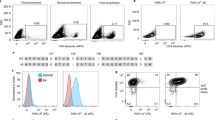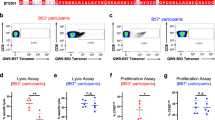Abstract
We investigated T-cell-defined HLA-B7 subtypes using cDNA sequencing, analysis of bound peptides, and reactivity with a panel of alloreactive cytotoxic T-lymphocyte (CTL) clones. Three subtypes (HLA-B*0702, HLA-B*0703, and HLA-B*0705) differ in nucleotide and predicted amino acid sequence. CTL reactivity and pooled peptide sequencing show that these three HLA-B7 subtypes bind distinct but overlapping sets of peptides. In particular B*0702 expresses D pocket residue Asp 114 and binds peptides with P3 Arg, whereas B*0705 expresses D pocket residue Asn 114 and binds peptides with P3 Ala, Leu, and Met. Consistent with different peptide-binding specificities, three alloreactive CTL differentiate between cells expressing B*0702, B*0703, and B*0705 by detecting specific peptide/HLA-B7 complexes. In contrast, three other T-cell-defined HLA-B7 subtypes are identical to HLA-B*0702. The B*0702-expressing cell lines are differentiated by two of ten CTL clones. One CTL clone differentiates B*0702-expressing cells by their ability to present peptide antigen. Thus differences in peptide presentation can explain differential CTL recognition of cell lines expressing structurally identical and variant HLA-B7.
Similar content being viewed by others
References
Aosai, F., Ohlen, C., Ljunggren, H. G., Hoglund, P., Franksson, L., Ploegh, H. Townsend, A., Karre, K., and Stauss, H. J. Different types of allospecific CTL clones identified by their ability to recognize peptide loading-defective target cells. Eur J Immunol 21: 2767–2774, 1991
Arnett, K. L., Adams, E. J., Domena, J. D., and Parham, P. Structure of a novel subtype of B7 (B*0705) isolated from a chinese individual. Tissue Antigens 44: 318–321, 1994
Bergmans, A. M., Tijssen, H., Lardy, N., and Reekers, P. Complete nucleotide sequence of HLA-B*0703, a B7 variant (BPOT). Hum Immunol 38: 159–162, 1993
Bevan, M. J. High determinant density may explain the phenom of alloreactivity. Immunol Today 5: 128–130, 1984
Bevan, M. J., Langman, R. E., and Cohn, M. H-2 antigen-specific cytotoxic T cells induced by concanavalin A: estimation of their relative frequency. Eur J Immunol 6: 150–156, 1976
Bluestone, J. A., Kaliyaperumal, A., Jamerson, S., Miller, S., and Dick, R. 2. Peptide-induced changes in class I heavy chains alter allorecognition. J Immunol 151: 3943–3953, 1993
Castano, A. R., Lauzurica, P., Domenech, N., and Lopez de Castro, J. A. Structural identity between HLA-A2 antigens differentially recognized by alloreactive cytotoxic T lymphocytes. J Immunol 146: 2915–2920, 1991
Cerundolo, V., Alexander, J., Anderson, K., Lamb, C., Cresswell, P., McMichael, A., Gotch, F., and Townsend, A. Presentation of viral antigen controlled by a gene in the major histocompability comlex. Nature 345: 449–452, 1990
Chomczynski, P. and Sacchi, N. Single-step method of RNA isolation by acid guanidinium thiocyanate-phenol-chloroform extraction. Anal Biochem 162: 156–159, 1987
Crumpacker, D. B., Alexander, J., Cresswell, P., and Engelhard, V. H. Role of endogenous peptides in murine allogenic cytotoxic T cell responses assessed using transfectants of the antigen-processing mutant 174×CEM.T2. J Immunol 148: 3004–3011, 1992
Elliott, T. J. and Eisen, H. N. Cytotoxic T lymphocytes recognize a reconstituted class I histocompatibility antigen (HLA-A2) as an allogeneic target molecule. Proc Natl Acad Sci USA 87: 5213–5217, 1990
Engelhard, V. H. Structure of peptides associated with MHC class I molecules. Curr Opin Immunol 6: 13–23, 1994
Ennis, P. D., Zemmour, J., Salter, R. D., and Parham, P. Rapid cloning of HLA-A, B cDNA by using the polymerase chain reaction: frequency and nature of errors produced in amplification. Proc Natl Acad Sci USA 87: 2833–2837, 1990
Fremont, D. H., Matsumura, M., Stura, E. A., Peterson, P. A., and Wilson, I. A. Crystal structures of two viral peptides in complex with murine MHC class I H-2Kb. Science 257: 919–927, 1992
Galocha, B., Lopez, D., and Lopez de Castro, J. A. Clonal heterogeneity in LFA-3 and ICAM-1 requirement for lysis by alloreactive T lymphocytes. J Immunol 150: 1653–1662, 1993
Guo, H. C., Jardetzky, T. S., Garrett, T. P., Lane, W. S., Strominger, J. L., and Wiley, D. C. Different lenght peptides bind to HLA-Aw68 similarly at their ends but bulge out in the middle. Nature 360: 364–366, 1992
Hadley, G. A. and Mohanakumar, T. Kidney cell-restricted recognition of MHC class I alloantigens by human cytolytoc T cell clones. Transplant 55: 400–404, 1993
Heath, W. R., Hurd, M. E., Carbone, F. R., and Sherman, L. A. Peptide-dependent recognition of H-2Kb by allreactive cytotoxic T lymphocytes. Nature 341: 749–752, 1989
Heath, W. R., Kane, K. P., Mescher, M. F., and Sherman, L. A. Alloreactive T cells discriminate among a diverse set of endogenous peptides. Proc Natl Acad Sci USA 88: 51015105, 1991
Heemels, M. T., Schumacher, T. N., Wonigeit, K., and Ploegh, H. L. Peptide translocation by variants of the transporter associated with antigen processing. Science 262: 2059–2063, 1993
Hill, A., Worth, A., Elliott, T., Rowland-Jones, S., Brooks, J., Rickinson, A. and MicMichael, A., Charaterization of two Epstein-Barr virus epitodes restricted by HLA-B7. Eur J Immunol 25: 18–24, 1995
Huczko, E. L., Bodnar, W. M., Benjamin, D., Sakaguchi, K., Zhun, N. Z., Shabanowitz, J., Henderson, R. A., Appella, E., Hunt, D. F., and Engelhard, V. H. Characteristics of endogenous peptides eluted from the class I MHC molecule HLA-B7 determined by mass spectrometry and computer modeling. J Immunol 151: 2572–2587, 1993
Hughes, A. L., Hughes, M. K., and Watkins, D. I. Contrasting roles of interallelic recombination at the HLA-A and HLA-B loci. Genetics 133: 669–680, 1983
Kurago, Z. B., Smith, K. D., and Lutz, C. T. Natural killer cell recognition of MHC class I: NK cells are sensitive to peptide binding groove and surface α-helical mutations that affect T cells. J Immunol 154: 2361–2641, 1995
Little, A. M., Domena, J. D., Hildebrand, W. H.;, Shen, S. Y., Barber, L. D., Marsh, S. G., Bias, W. B., and Parham, P. HLA-B67: a member of the HLA-B16 family that expresses the ME1 epitope. Tissue Antigens 43: 38–43, 1994
Loveland, B., Wang, C. R., Yonekawa, H., Hermel, E., and Fischer Lindahl, K. Maternally transmitted histocompatibility antigen of mice: a hydrophobic peptide of a mitochondrially encoded protein. Cell 60: 971–980, 1990
Madden, D. R., Garboczi, D. N., and Wiley, D. C. The antigenic identity of peptide-MHC complexes: a comparison of the conformations of five viral peptides presented by HLA-A2. Cell 75: 693–708, 1993
Maier, R., Falk, K., Rötzschke, O., Maier, B., Gnau, V., Stevanović, S., Jung, G., Rammensee, H.-G., and Meyerhans, A. Peptide motifs of HLA-A3, −A24, and −B7 molecules as determined by pool sequencing. Immunogenetics 40: 306–308, 1994
Marrack, P. and Kappler, J. T cells can distinguish between allogeneic major histocompatibility complex products on different cell types. Nature 332: 840–843, 1988
Masucci, M. G., Zhang, Q. J., Gavioli, R., De Campos-Lime, P. O., Murray, R. J., Brooks, J., Griffin, H., Ploegh, H., and Rickinson, A. B. Immune escape by Epstein-Barr virus (EBV) carrying Burkitt's lymphona: in vitro reconstitution of sensitivity to EBV-specific cytotoxic T cells. Int Immunol 4: 1283–1292, 1992
Matsumura, M., Fremont, D. H., Peterson, P. A., and Wilson, I. A. Emerging principles for the recognition of peptide antigens by MHC class I molecules. Science 257: 927–934, 1992
Matzinger, P. and Bevan, M. J. Hypothesis: why do so many lymphocytes respond to major histocompatibility antigens? Cell Immunol 29: 1–5, 1977
McCutcheon, J. A., Smith, K. D., Valenzuela, A., Aalbers, K., and Lutz, C. T. HLA-B*0702 anitbody epitopes are affected indirectly by distant antigen residues. Hum Immunol 36: 69–75, 1993
Ohlen, C., bastin, J., Ljunggaren, H. G., Foster, L., Wolpert, E., Klein, G., Townsend, A. R., and Karre, K. Resistance to H-2-restricted but not to allo-H2-specific graft and cytotoxic T lymphocyte responses in lymphoma mutant. J Immunol 145: 52–58, 1990
Parham, P. Purificationof immunologically active HLA-A and −B antigens by a series of monoclonal antibody columns. J Biol Chem 254: 8709–8712, 1979
Powis, S. J., Deverson, E. V., Coadwell, W. J., Ciruela, A., Huskisson, N. S., Smith, H., Butcher, G. W., and Howard, J. C. Effect of polymorphism of an MHC-linked transporter on the peptides assembled in a class I molecule. Nature 357: 211–215, 1992
Powis, S. J., Howard, J. C., and Butcher, G. W. The major histocompatibility complex class II-linked cim locus controls the kinetics of intracellular transport of a classical class I module. J Exp Med 173: 913–921, 1991
Reekers, P., van der Beucken, M., Andrien, M., Beelen, J., Mueller-Eckhardt, G., and Schreuder, G. M. HLA-B POT: a new HLA-antigen within the B7-cross reactive group. Tissue Antigens 28: 182–189, 1986
Rötzschke, O., Falk, K., Faath, S., and Rammensee, H.-G. On the nature of peptides involved in T cell alloreactivity. J Exp Med 174: 1059–1071, 1991
Rötzschke, O., Falk, K., Wallny, H. J., Faath, S., and Rammensee, H.-G. Characterization of naturally occuring minor histocompatibility peptides including H-4 and H-Y. Science 249: 283–287, 1990
Salter, R. D., Howell, D. N., and Cresswell, P. Genes regulating HLA class I antigen expression in T-B lymphoblast hybrids. Immunogenetics 21: 235–246, 1985
Santamaria, P., Boyce-Jacino, M. T., Lindstrom, A. L., Rich, S. S., Faras, A. J., and Barbosa, J. J. Alloreactive T cells can distinguish between the same human class II MHC products on different B cell lines. J Immunol 146: 1822–1828, 1991
Saper, M. A., Bjorkman, P. J., and Wiley, D. C. Refined structure of the human histocompatibility antigen HLA-A2 at 2.6 Å resolution. J Mol Biol 219: 277–319, 1991
Sekimata, M., Griem, P., Egawa, K., Rammensee, H.-G., and Takiguchi, M. Isolation of human minor histocompatibility peptides. Int Immunol 4: 301–304, 1992
Sherman, L. A. and Chattopadhyay, S. The molecular basis of allorecognition. Annu Rev Immunol 11: 385–402, 1993
Silver, M. L., Guo, H. C., Strominger, J. L., and Wiley, D. C. Atomic structure of a human MHC molecule presenting an influenza virus peptide. Nature 360: 367–369, 1992
Smith, K. D., Valenzuela, A., Vigna, J. L., Aalbers, K., and Lutz, C. T. Unwanted mutations in PCR mutagenesis: avoiding the predictable. PCR Meth & Appl 2: 253–257, 1993
Spits, H., Breuning, M., Ivanyi, P., Russo, C., and de Vries, J. E. In vitro-isolated human cytotoxic T-lymphocyte clones detect variations in serologically defined HLA antigens. Immunogenetics 16: 503–512, 1982
Springer, T. A. Adhesion receptors of the immune system. Nature 346: 425–434, 1990
Taketani, S., Krangel, M. S., Spits, H., de Vries, J., and Strominger, J. L. Structural analysis of an HLA-B7 antigen variant detected by cytotoxic T lymphocytes. J Immunol 133: 816–821, 1984
Udaka, K., Tsomides, T. J., and Eisen, H. N. A ubiquitous protein is the source of naturally occuring peptides that are recognized by a CD8+ T-cell clone. Proc Natl Acad Sci USA 90: 11272–11276, 1993
Van Seventer, G. A., Huis, B., Melief, C. J., and Ivanyi, P. Fine specificity of human HLA-B7-specific cytotoxic T-lymphocyte clones. I. Identification of HLA-B7 subtypes and histotopes of the HLA-B7 cross-reacting group. Hum Immunol 16: 375–389, 1986
Van Seventer, G. A., Spits, H., Yssel, H., Melief, C. J., and Ivanyin, P. Differential recognition by human cytotoxic T cells clones of human M1 fibroblasts transfered with an HLA-B7 gene (JY150) suggests the existence of two different HLA-B7 alleles in the cell line JY (HLA-A2,2;B7,7;Cw-,-;DR4,w6). J Immunol 141: 417–422, 1988
Wallny, H. J. and Rammensee, H.-G. Identification of classical minor histocompatibility antigen as cell-derived peptide. Nature 343: 275–278, 1990
Wang, C. R., Loveland, B. E., and Fischer Lindahl, K. H-2M3 encodes the MHC class I molecule presenting the maternally transmitted antigen of the mouse. Cell 66: 335–345, 1991
Zemmour, J and Parham, P. HLA class I nucleotide sequences, 1992. Hum Immunol 34: 225–241, 1992
Author information
Authors and Affiliations
Rights and permissions
About this article
Cite this article
Smith, K.D., Epperson, D.F. & Lutz, C.T. Alloreactive cytotoxic T-lymphocyte-defined HLA-B7 subtypes differ in peptide antigen presentation. Immunogenetics 43, 27–37 (1995). https://doi.org/10.1007/BF00186601
Received:
Issue Date:
DOI: https://doi.org/10.1007/BF00186601




